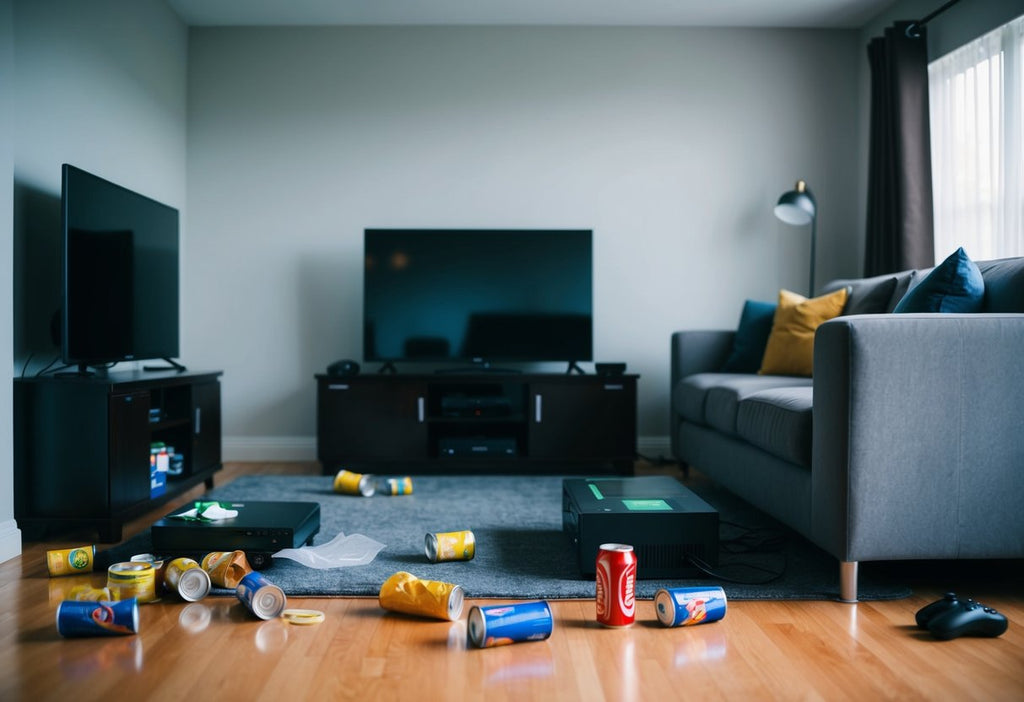How Long Does It Take to Lose Muscle

Don’t forget to check out our Pacerocker, Trailviber, and Trailviber Auto Incline walking pad treadmills.
Muscle loss is a common concern for fitness enthusiasts and athletes alike. We've all wondered how quickly our hard-earned gains might disappear if we take a break from training. Typically, noticeable muscle loss begins within 2-3 weeks of inactivity, but the rate can vary based on factors like age, fitness level, and diet.
Our muscles are in a constant state of flux, responding to the demands we place on them. When we stop exercising, our body begins to adapt by reducing muscle mass. This process, known as atrophy, can be frustrating for those who've invested time and effort in building their physique.
Diet plays a crucial role in maintaining muscle mass during periods of inactivity. Adequate protein intake and overall calorie consumption can help slow down muscle loss. Staying active, even with light exercises, can also make a significant difference in preserving muscle tissue.
Key Takeaways
- Muscle loss typically begins within 2-3 weeks of inactivity
- Diet and light exercise can help slow down muscle atrophy
- Regaining lost muscle is often faster than building it initially
Understanding Muscle Atrophy
Muscle atrophy, the process of muscle loss, can occur rapidly under certain conditions. Let's explore the biological mechanisms behind muscle breakdown and the key factors that influence this process.
Biological Process of Muscle Loss
Muscle atrophy begins when protein breakdown exceeds protein synthesis. This imbalance leads to a reduction in muscle fiber size and strength. Our bodies constantly cycle through protein synthesis and breakdown, but when breakdown dominates, we lose muscle mass.
Several molecular pathways are involved in this process. The ubiquitin-proteasome system plays a crucial role by tagging proteins for destruction. Additionally, autophagy, a cellular recycling process, can contribute to muscle loss when overactivated.
Hormonal changes also impact muscle maintenance. Decreased levels of anabolic hormones like testosterone and growth hormone can accelerate muscle breakdown.
Factors Influencing Muscle Atrophy
Inactivity is a primary driver of muscle loss. When we don't use our muscles, our bodies reduce protein synthesis to conserve energy. This can happen quickly - even a few days of bed rest can lead to noticeable muscle loss.
Aging is another significant factor. As we get older, our bodies become less efficient at building and maintaining muscle mass. This age-related muscle loss is called sarcopenia.
Nutrition plays a vital role too. Insufficient protein intake can speed up muscle breakdown. Calorie restriction, while beneficial for weight loss, can also lead to muscle loss if not managed carefully.
Certain medical conditions can accelerate muscle atrophy. Diseases like cancer, AIDS, and chronic obstructive pulmonary disease often cause rapid muscle wasting. Some medications, particularly corticosteroids, can also contribute to muscle loss.
Timeframe of Muscle Loss
Muscle loss occurs gradually over time when we stop exercising or reduce our physical activity. The rate and extent of muscle loss can vary based on factors like age, fitness level, and nutrition.
Initial Changes and Detraining
Within the first week of inactivity, we might notice a decrease in muscle strength. This initial loss is often due to neurological changes rather than actual muscle atrophy.
After 2-3 weeks, we start to see measurable reductions in muscle size. For athletes, this detraining effect can lead to a 5-10% decrease in muscle mass over 3-4 weeks of complete inactivity.
Older adults may experience faster muscle loss, potentially losing up to 1% of muscle mass per day when bedridden.
Long-Term Muscle Atrophy
Extended periods of inactivity lead to more significant muscle loss. After 3-6 months without exercise, we can lose up to 50% of our strength gains.
Age plays a crucial role in long-term muscle atrophy. Adults over 30 naturally lose 3-5% of muscle mass per decade, a process called sarcopenia.
Severe muscle wasting, such as in cases of prolonged bed rest or space travel, can result in up to 20% muscle loss in just 5-11 days.
Regular resistance training and proper nutrition can slow or even reverse muscle loss in many cases.
Effects of Physical Inactivity
Physical inactivity can lead to significant changes in our bodies. These changes impact both muscle mass and metabolic function, with far-reaching consequences for our overall health and fitness.
Impact on Muscle Mass
When we stop exercising, our muscles begin to atrophy quickly. Within just 72 hours of inactivity, we can start losing muscle mass. This loss accelerates over time, with noticeable decreases occurring within 2-3 weeks of stopping regular exercise.
Muscle fibers shrink in size and number, leading to reduced strength and power. Our bodies become less efficient at synthesizing proteins, a crucial process for maintaining muscle tissue. This decline is particularly pronounced in fast-twitch muscle fibers, which are responsible for explosive movements and strength.
Metabolic Consequences
Physical inactivity significantly alters our metabolism. Our resting metabolic rate decreases, meaning we burn fewer calories at rest. This can lead to weight gain and increased body fat percentage.
Insulin sensitivity declines, making it harder for our bodies to regulate blood sugar levels. This can increase the risk of developing type 2 diabetes. Our cardiovascular fitness also suffers, with a decrease in heart and lung efficiency.
Bone density may decrease, especially in weight-bearing areas, increasing the risk of osteoporosis. Additionally, our bodies become less efficient at processing fats and carbohydrates, potentially leading to higher cholesterol levels and increased risk of cardiovascular disease.
Influence of Diet and Nutrition
Diet and nutrition play crucial roles in muscle preservation during periods of inactivity or calorie restriction. The foods we consume and our overall nutritional intake can significantly impact how quickly muscle mass is lost or maintained.
Protein Intake and Muscle Preservation
Adequate protein consumption is essential for maintaining muscle mass. We recommend aiming for 1.6 to 2.2 grams of protein per kilogram of body weight daily to minimize muscle loss. High-quality protein sources include lean meats, fish, eggs, and dairy products.
Spreading protein intake evenly throughout the day can enhance muscle preservation. Consuming 20-30 grams of protein per meal seems optimal for stimulating muscle protein synthesis.
Supplementing with branched-chain amino acids (BCAAs) may also help reduce muscle breakdown, especially during periods of calorie restriction or intense training.
Role of Calories and Macronutrients
Maintaining an appropriate calorie intake is vital for preserving muscle mass. Drastic calorie cuts can accelerate muscle loss, even with adequate protein intake.
A moderate calorie deficit of 10-20% below maintenance levels is generally recommended for fat loss while minimizing muscle loss. This approach allows for gradual weight loss without sacrificing lean tissue.
Balancing macronutrients is key. While protein is crucial, carbohydrates and fats also play important roles in muscle preservation. Carbs help maintain training intensity and recovery, while healthy fats support hormone production.
A balanced macronutrient ratio might look like:
- Protein: 30-35%
- Carbohydrates: 40-50%
- Fats: 20-30%
Training Interventions to Prevent Loss
Maintaining muscle mass requires a proactive approach through targeted exercise strategies. We'll explore key training methods to minimize muscle loss and keep our gains intact.
Resistance Training
Resistance training is crucial for preserving muscle mass. We should prioritize compound exercises like squats, deadlifts, and bench presses to engage multiple muscle groups simultaneously. Aim for 2-3 strength training sessions per week, focusing on progressive overload by gradually increasing weights or reps.
Incorporating both eccentric and concentric movements helps stimulate muscle fibers and prevent atrophy. We can also include bodyweight exercises like push-ups and pull-ups to maintain strength and muscle tone.
Consistency and Workout Frequency
Consistency is key in preventing muscle loss. We should establish a regular workout routine and stick to it, even during busy periods or while traveling. Aim for at least 3-4 training sessions per week to maintain muscle mass effectively.
Varying workout intensity can help prevent plateaus and keep our muscles challenged. We can alternate between high-intensity sessions and lighter recovery workouts. It's also important to allow for adequate rest between sessions to promote muscle repair and growth.
Tracking our progress through workout logs or fitness apps can help us stay motivated and ensure we're maintaining our strength levels over time.
Recovery and Muscle Regain
Rebuilding lost muscle mass requires a strategic approach combining proper nutrition, targeted exercise, and adequate rest. We'll explore effective strategies and highlight the crucial role of recovery in regaining muscle.
Strategies for Muscle Rebuilding
To regain lost muscle, we need to focus on resistance training and protein intake. Aim for 3-4 strength training sessions per week, targeting all major muscle groups. Increase weights gradually to challenge muscles and stimulate growth.
Nutrition plays a key role. We recommend consuming 1.6-2.2 grams of protein per kilogram of body weight daily. Spread protein intake evenly across meals and include a serving within 30 minutes post-workout.
Incorporate compound exercises like squats, deadlifts, and bench presses. These movements engage multiple muscle groups, promoting overall muscle growth and strength gains.
Importance of Rest and Recovery
Rest is crucial for muscle rebuilding. We need to allow 48-72 hours between workouts for the same muscle group. This downtime enables muscle repair and growth.
Quality sleep is essential. Aim for 7-9 hours nightly to optimize hormone production, including growth hormone and testosterone, which aid muscle recovery.
Active recovery techniques can speed up the process. Try light cardio, yoga, or stretching on rest days to improve blood flow and reduce muscle soreness.
Proper hydration supports recovery. We should drink at least 8-10 glasses of water daily, adjusting for activity level and climate.
Importance of a Holistic Approach
When it comes to maintaining muscle mass, we can't focus on just one aspect of our lifestyle. A holistic approach considers all factors that influence muscle retention and overall health.
Nutrition plays a crucial role. We need to ensure we're consuming enough protein, complex carbohydrates, and healthy fats to support muscle tissue. Adequate hydration is also essential for optimal muscle function.
Exercise is another key component. Resistance training helps stimulate muscle growth and maintenance, while cardiovascular activities support overall fitness and metabolism.
Rest and recovery are often overlooked but equally important. Our muscles need time to repair and grow stronger after workouts. Quality sleep and stress management contribute significantly to this process.
Consistency is vital in all these areas. We can't expect to maintain muscle mass with sporadic efforts. It requires ongoing commitment to a balanced lifestyle.
By addressing all these factors together, we create a synergistic effect. Each element supports the others, leading to better results in muscle retention and overall health.
Case Studies and Real-World Examples
We've collected some fascinating real-world examples of muscle loss to illustrate how quickly it can occur. These cases highlight the importance of consistent training and proper nutrition.
Professional Athletes: A study of soccer players showed significant muscle loss after just 2 weeks of inactivity. Their leg muscle volume decreased by 6.5% during this short period.
Astronauts: Astronauts experience rapid muscle loss in zero gravity. NASA reports that astronauts can lose up to 20% of their muscle mass during space missions lasting 5-11 days.
Bed Rest Studies: Research on healthy adults undergoing bed rest revealed:
- 1 week: 1-2% muscle loss
- 2 weeks: 2-3% muscle loss
- 3 weeks: 4-5% muscle loss
Injury Recovery: A case study of a professional bodybuilder with a leg injury showed a 10% reduction in thigh muscle size after just 3 weeks of immobilization.
Aging Population: We observed a group of seniors who stopped their regular exercise routine. Within 4 weeks, they experienced a 5-8% decrease in muscle mass and strength.
These examples demonstrate that muscle loss can occur rapidly, especially without proper exercise and nutrition. It's crucial to maintain consistent habits to preserve muscle mass and strength.
Frequently Asked Questions
Muscle loss can occur at different rates depending on various factors like activity level, nutrition, and overall health. Let's explore some common questions about the timeline of muscle atrophy.
What is the typical timeframe for muscle atrophy due to inactivity?
Muscle atrophy typically begins within 2-3 weeks of inactivity. We start to see noticeable decreases in muscle mass and strength after about 3-4 weeks of complete inactivity.
The rate of muscle loss can vary based on factors like age, fitness level, and overall health.
Can taking a week off from exercise lead to muscle loss?
A single week off from exercise is unlikely to cause significant muscle loss for most people. Our bodies can maintain muscle mass for short periods of inactivity.
This brief break may even be beneficial, allowing for recovery and preventing overtraining.
If I stop working out, after how many days does muscle loss begin?
Muscle loss typically begins after about 5-7 days of complete inactivity. However, this initial loss is often due to decreased glycogen stores and water retention.
Actual muscle protein breakdown usually starts around the 2-week mark of inactivity.
During an illness or bed rest, how quickly can muscles start to atrophy?
Muscles can start to atrophy within 3-5 days during bed rest or severe illness. This rapid loss is often due to the combination of inactivity and inadequate nutrition.
Older adults and those with chronic conditions may experience faster muscle loss.
After ceasing physical training, how long does it generally take to regain lost muscle mass?
Regaining lost muscle mass typically takes about half the time it took to lose it. For example, if muscle loss occurred over 4 weeks, it might take about 2 weeks to rebuild.
Consistency in training and proper nutrition are key factors in muscle regain.
Is a two-week break from the gym enough time to cause noticeable muscle loss?
A two-week break from the gym may result in some minor muscle loss, but it's usually not significant for most people. We might notice a slight decrease in strength or muscle fullness.
Regular exercisers can often regain any lost progress within a week or two of returning to their routine.
Meta description:
Learn how quickly muscle loss starts, the factors that affect it, and how to prevent or regain lost muscle through smart nutrition, exercise, and recovery strategies.







